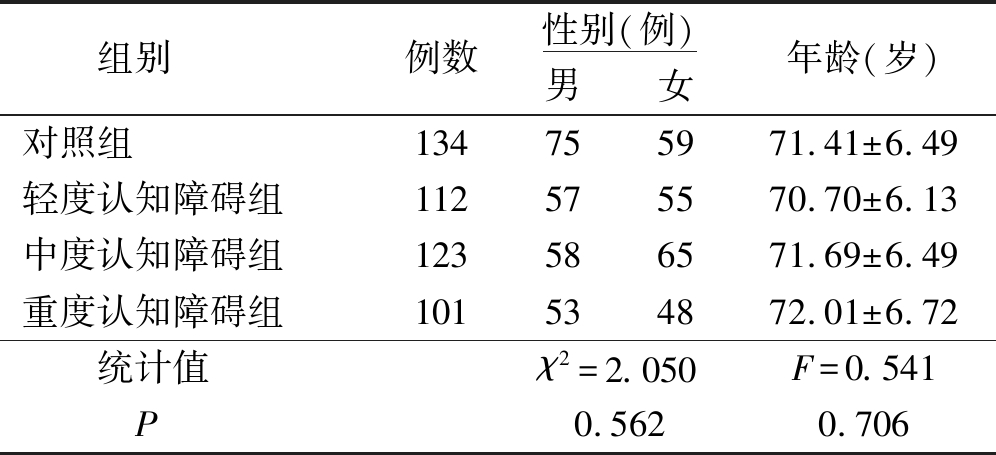认知障碍(cognitive impairment,CI)与衰弱是异常老化所致的综合征,在老年人群中高发,是老龄化所面临的主要问题之一,给个人、家庭与社会均带来巨大威胁[1],也是目前研究的两大热点。认知障碍包括轻度认知障碍到痴呆的整个过程,主要表现为大脑皮层某些或整体认知领域的功能障碍,已成为重要的公共卫生问题[2-3],衰弱则是一种以生理功能、肌肉和耐力下降为主要表现的老年综合征,增加了不良健康结局,比如住院、功能障碍、甚至死亡发生的风险[4-5],其中握力与步速较低是衰弱和衰弱前期老年人的常见表现[6-7],与认知障碍的发生及进展密切相关[8],但目前国内针对握力和步速与认知功能关系的调查研究较少。因此,本研究初步探讨握力和步速与认知功能的关系,旨在为认知障碍的预防干预提供参考。
1 对象与方法
1.1 调查对象 本研究采用便利抽样法调查2018年3月—6月郑州市中牟县3所医院的神经内科门诊及老年科室住院病人。纳入标准:年龄≥60岁,同意参与本研究者。排除标准:严重视力及听力障碍等沟通困难者;严重骨关节或手部疾病等影响步行或手臂力量疾病的病人;已明确诊断的严重精神病病人。
1.2 调查工具
1.2.1 一般情况调查表 该问卷为自行设计,主要包括年龄、性别、教育程度、婚姻状况等。
1.2.2 简易精神状态量表(Mini-Mental State Examination,MMSE) 该量表简便易行,是目前国内外应用最广泛的认知筛查量表。所涵盖的认知领域包括定向力(时间和地点)、记忆力(即刻记忆和延迟回忆)、注意力和计算能力、语言能力(命名、复述、阅读、书写、理解)和视空间能力。量表共30个项目,每项回答或操作正确计1分,总分范围为0~30分。多数研究将其划分为正常认知≥24分,轻度认知障碍21~23分,中度认知障碍11~20分,重度认知障碍≤10分,信效度良好[9-11]。
1.2.3 握力与步速检查 选用国际使用较为广泛的Jamar握力计[12],具体测量方法如下:受试者采用便利手,取坐位,双腿屈膝90°,前臂中立位,伸腕0~30°,尺偏0~15°,嘱咐老年人快速用力,重复测量2次,2次测量间隔1 min,取两次测量的平均值,作为握力测试结果。步速则采用5 m步行距离,为保证老年人行走安全,对其日常步行速度进行测评,来回走2次,取其平均值作为最终的步速值。
1.3 调查方法 采用问卷调查法,研究者说明调查目的,征得郑州市中牟县3所医院领导同意,在发放问卷前取得病人知情同意,对老年人进行评估。首先对老年人进行认知评估,在符合认知纳入标准情况下,进行握力与步速测量,具体步骤为:2018年3月从体检中心筛选出MMSE≥24分病人,测量其握力与步速,作为对照组;2018年4月—6月筛选出MMSE≤21分病人,并测量其握力与步速,现场回收问卷。共发放问卷496份,回收496份,有效回收470份,有效回收率94.8%。
1.4 统计学方法 采用SPSS 21.0统计软件进行数据分析,统计方法主要采用χ2检验、方差分析、Pearson相关分析。显著性水平α=0.05。
2 结果
2.1 一般情况 根据MMSE得分将老年人分为4组:对照组134名、轻度认知障碍组112例,中度认知障碍组123例,重度认知障碍组101例。4组之间年龄、性别差异无统计学意义(P>0.05)。见表1。
表1 各组老年人一般资料比较

组别例数性别(例)男女年龄(岁)对照组13475 5971.41±6.49轻度认知障碍组11257 5570.70±6.13中度认知障碍组12358 6571.69±6.49重度认知障碍组10153 4872.01±6.72 统计值χ2=2.050F=0.541 P0.5620.706
2.2 对照组与不同认知障碍程度老年人握力与步速比较 4组不同认知程度老年人的握力与步速差异有统计学意义(P<0.05)。与对照组比较,轻度认知障碍组握力和步速值差异均无统计学意义(P>0.05),中重度组握力与步速值均明显下降,且差异均有统计学意义(P<0.05);与轻度认知障碍组比较,中重度认知障碍组握力和重度认知障碍组步速均明显下降,且差异均有统计学意义(P<0.05);与中度认知障碍组比较,重度认知障碍组握力与步速均明显下降,差异有统计学意义(P<0.05)。见表2。
2.3 认知功能与握力和步速的相关性 根据MMSE项目,将认知功能分为定向力、记忆力、注意与计算能力、语言能力和视空间能力5项,握力与步速均与认知总得分、定向力、语言能力得分呈正相关(P<0.01)。见表3。
表2 正常认知组与不同认知障碍程度老年人握力与步速比较![]()

组别例数握力(kg)步速(m/s)对照组13426.92±7.990.92±0.21轻度认知障碍组11227.10±6.640.82±0.18中度认知障碍组123 23.01±8.141)2)0.80±0.161)重度认知障碍组101 15.02±5.011)2)3) 0.59±0.161)2)3) F值9.7549.851 P<0.001<0.001
1) 与对照组比较,P<0.05;2) 与轻度认知障碍组比较,P<0.05;3) 与中度认知障碍组比较,P<0.05
表3 认知得分与握力和步速测评结果的相关性分析(r值)

项目MMSE得分定向力记忆力注意与计算力语言能力视空间能力握力0.3571)0.4911)0.1090.1300.3241)0.1542)步速0.2701)0.4011)0.0700.1110.2061)0.085
1) P<0.01;2) P<0.05
3 讨论
衰弱与认知障碍之间的关联可能与相关激素水平失衡、慢性炎症、心血管危险因素等有关[13],低握力与步速水平是衰弱诊断参考的重要因素,也是老年人身体机能的重要表现,二者与认知功能的关系密切[14]。本研究显示,分别与对照组和轻度认知障碍组比较,中重度认知障碍组握力与步速值均明显下降,但相比对照组,轻度认知障碍组握力与步速并无明显变化。有研究显示,认知下降先于握力下降,认知能力下降越大,握力下降越大[15],且不同的认知障碍类型老年人步速具有差异性[16],较低的日常步速与较重的认知障碍相关[17],步速对认知功能的影响在认知障碍后期可能更显著[18-19],中重度认知障碍相比轻度认知障碍和正常认知老年人转变为痴呆的风险更大,所处认知障碍阶段认知受损更严重,握力与步速变化更明显。农村常年以农业生产为主,即使老年阶段也多会从事一些简单的生产,而轻度认知障碍老年人皮质层轻微受损,日常生活能力保持,农业生产活动与正常认知老年人并无很大异样,长期的活动有利于肌肉力量与行走速度的保持或增强,从而促使轻度认知障碍与正常认知老年人相比,握力与步速变化并不明显。
本研究显示,握力和步速均与整体认知功能、定向力、语言能力呈正相关,同时握力与视空间能力也呈正相关。握力和步速与整体认知功能呈正相关,与文献[20]的研究结果一致,其原因可能与老年人额叶、顶叶和颞叶神经细胞损伤或丧失有关,特别是与胆碱能和单胺能神经递质功能减退密切相关[21-22]。有研究显示握力对空间定向能力和语言能力具有一致的正向影响,且该影响在65岁以上老年人中更明显,并认为具体认知功能比整体认知功能对未来生存质量的影响更大,其机制可能与握力和认知具有相似的变异性及共同的致病因素有关[23-24];还有研究也显示步速与言语流畅性呈正相关[8],均与本研究结果一致。定向和语言能力与运动功能所涉及的平衡与肌张力等均主要由神经皮层中的额叶支配,认知定向和语言能力受损是额叶皮层神经元丧失或损伤的表现,老年人运动前区同时受到影响,二者可能因此呈现出同向影响。目前步速和握力与定向力和语言能力关系的研究较少,与认知障碍中常见的记忆障碍关系结论不一[25],未来可采用大样本进一步调查研究定向力、语言能力和记忆力等具体认知维度与握力和步速之间的关系,为今后老年认知障碍的筛查与预防干预提供实证介入的参考。
4 小结
综上所述,握力和步速与中重度认知障碍关系密切,与整体认知、语言与定向力呈正相关,因此在对老年人进行认知评估时,可将握力与步速作为辅助指标,提高诊断的准确性。而在制定相关干预措施时,应同时考虑到认知与身体机能的改善效果,可采取认知与运动相结合的干预方法,比如具备平衡与有氧运动功能的太极拳运动[26],长期规律运动有利于认知与躯体功能的改善[27],但针对文化水平普遍较低且相关认知活动较少的农村老年人则更应加重认知方面的训练。
[1] ST J P,TYAS S L,GRIFFITH L E,et al.The cumulative effect of frailty and cognition on mortality - results of a prospective cohort study[J].Int Psychogeriatr,2017,29(4):535-543.
[2] JIA J,WANG F,WEI C,et al.The prevalence of dementia in urban and rural areas of China[J] .Alzheimers Dement,2014,10(1):1-9.
[3] FERNANDEZ-BLAZQUEZ M A,AVILA-VILLANUEVA M,MAESTU F,et al.Specific features of subjective cognitive decline predict faster conversion to mild cognitive impairment[J].J Alzheimers Dis,2016,52(1):271-281.
[4] MORLEY J E,VELLAS B,VAN KAN G A,et al.Frailty consensus:a call to action [J].J Am Med Dir Assoc,2013,14(6):392-397.
[5] LEE L,HECKMAN G,MOLNAR F J.Frailty:identifying elderly patients at high risk of poor outcomes[J].Can Fam Physician,2015,61(3):227-231.
[6] FENG L,NYUNT M S Z,GAO Q,et al.Physical frailty,cognitive impairment,and the risk of neurocognitive disorder in the singapore longitudinal ageing studies[J].J Gerontol A Biol Sci Med Sci,2016,72(3):369-375.
[7] 徐忠梅,于卫华,吴梦余.老年病人虚弱前期状态与常速行走步态特征的关系研究[J].护理研究,2018,32(7):1144-1147.
[8] HOOGHIEMSTRA A M,RAMAKERS I H,SISTERMANS N,et al.Gait speed and grip strength reflect cognitive impairment and are modestly related to incident cognitive decline in memory clinic patients with subjective cognitive decline and mild cognitive impairment:findings from the 4C study[J].J Gerontol A Biol Sci Med Sci,2017,72(6):846-854.
[9] 王学义,张平.痴呆[M].天津:天津科学技术出版社,2004:15-23.
[10] 田金洲.血管性痴呆[M].北京:人民卫生出版社,2003:352-357.
[11] 唐桂华,陈卓铭,李冰肖.汉语认知功能测评量表的比较[J].中国组织工程研究,2004,8(19):3882-3884.
[12] 欧阳敏,蹇在金.老年衰弱评估研究进展[J].中国实用内科杂志,2017,37(4):317-321.
[13] SARGENT L,NALLS M,STARKWEATHER A,et al.Shared biological pathways for frailty and cognitive impairment:a systematic review[J].Ageing Res Rev,2018,47:149-158.
[14] 王洁,莫永珍,李咏阳,等.社区75岁及以上女性衰弱指标与认知功能的相关性分析[J].实用老年医学,2017(11):1087-1089.
[15] FRITZ N E,MCCARTHY C J,ADAMO D E.Handgrip strength as a means of monitoring progression of cognitive decline-a coping review[J].Ageing Res Rev,2017,35:112-123.
[16] GILLAIN S,DRAMÉ M,LEKEU F,et al.Gait speed or gait variability,which one to use as a marker of risk to develop Alzheimer disease? A pilot study[J].Aging Clin Exp Res,2016,28(2):249-255.
[17] MCGOUGH E L,COCHRANE B B,PIKE K C,et al.Dimensions of physical frailty and cognitive function in older adults with amnestic mild cognitive impairment[J].Ann Phys Rehabil Med,2013,56(5):329-341.
[18] TIAN Q,AN Y,RESNICK SM,et al.The relative temporal sequence of decline in mobility and cognition among initially unimpaired older adults:results from the baltimore longitudinal study of aging[J].Age Ageing,2017,46:445-451.
[19] GALE C R,ALLERHAND M,SAYER A A,et al.The dynamic relationship between cognitive function and walking speed:the English longitudinal study of ageing[J].Age,2014,36:9682.
[20] GARCIA-PINILLOS F,COZAR-BARBA M,MUNOZ-JIMENEZ M,et al.Gait speed in older people:an easy test for detecting cognitive impairment,functional independence,and health state[J].Psychogeriatrics,2016,16(3):165-171.
[21] JERNIGAN T L,ARCHIBALD S L,FENNEMA-NOTESTINE C,et al.Effects of age on tissues and regions of the cerebrum and cerebellum[J].Neurobiol Aging,2001,22:581-594.
[22] WISE R A.Dopamine,learning and motivation[J].Nat Rev Neurosci,2004,5:483-494.
[23] STERNANG O,REYNOLDS C A,FINKEL D,et al.Grip strength and cognitive abilities:associations in old age[J].J Gerontol B Psychol Sci Soc Sci,2016,71(5):841-848.
[24] PRAETORIUS BJÖRK M,JOHANSSON B,HASING L B.I forgot when I lost my grip—strong associations between cognition and grip strength in level of performance and change across time in relation to impending death[J].Neurobiol Aging,2016,38:68-72.
[25] UMEGAKI H,MAKINO T,YANAGAWA M,et al.Maximum gait speed is associated with a wide range of cognitive functions in Japanese older adults with a Clinical Dementia Rating of 0.5[J].Geriatr Gerontol Int,2018,18(9):1323-1329.
[26] SUNGKARAT S,BORIPUNTAKUL S,CHATTIPAKORN N,et al.Effects of Tai Chi on cognition and fall risk in older adults with mild cognitive impairment:a randomized controlled trial[J].J Am Geriatr Soc,2016,65(4):721.
[27] BOOTH V,HOOD V,KEARNEY F.Interventions incorporating physical and cognitive elements to reduce falls risk in cognitively impaired older adults:a systematic review[J].JBI Database System Rev Implement Rep,2016,14(5):110-135.
